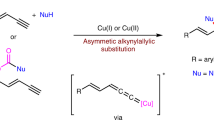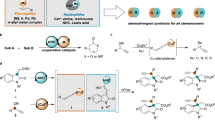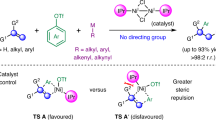Abstract
A rapidly emerging set of catalytic reactions involves intermediates that contain a copper-substituted stereogenic carbon centre. Here, we demonstrate that an intimate understanding of this distinction provides ways for addressing limitations in reaction scope and explaining why unexpected variations in enantioselectivity often occur. By using catalytic enantioselective Cu–boryl addition to alkenes as the model process, we elucidate several key mechanistic principles. We show that higher electrophile concentration can lead to elevated enantioselectivity. This is because diastereoselective Cu–H elimination may be avoided and/or achiral Cu–boryl intermediates can be converted to allyl–B(pin) rather than add to an alkene. We illustrate that lower alkene amounts and/or higher chiral ligand concentration can minimize the deleterious influence of achiral Cu–alkyl species, resulting in improved enantiomeric ratios. Moreover, and surprisingly, we find that enantioselectivities are higher with the less reactive allylphenyl carbonates as chemoselective copper–hydride elimination is faster with an achiral Cu-alkyl species.
This is a preview of subscription content, access via your institution
Access options
Access Nature and 54 other Nature Portfolio journals
Get Nature+, our best-value online-access subscription
$29.99 / 30 days
cancel any time
Subscribe to this journal
Receive 12 print issues and online access
$259.00 per year
only $21.58 per issue
Buy this article
- Purchase on Springer Link
- Instant access to full article PDF
Prices may be subject to local taxes which are calculated during checkout





Similar content being viewed by others
References
Lee, Y. & Hoveyda, A. H. Efficient boron–copper additions to aryl-substituted alkenes promoted by NHC-based catalysts. Enantioselective Cu-catalyzed hydroboration reactions. J. Am. Chem. Soc. 131, 3160–3161 (2009).
Jia, T . et al. A Cu/Pd cooperative catalysis for enantioselective allylboration of alkenes. J. Am. Chem. Soc. 137, 13760–13763 (2015).
Lee, Y., Jang, H. & Hoveyda, A. H. Vicinal diboronates in high enantiomeric purity through tandem site-selective NHC-Cu-catalyzed boron-copper additions to terminal alkynes. J. Am. Chem. Soc. 131, 18234–18235 (2009).
Meng, F., Jang, H. & Hoveyda, A. H. Exceptionally E- and β-Selective NHC-Cu-catalyzed proto-silyl additions to terminal alkynes and site- and enantioselective proto-boryl additions to the resulting vinylsilanes: synthesis of enantiomerically enriched vicinal and geminal borosilanes. Chem. Eur. J. 19, 3204–3214 (2013).
Nishikawa, D., Hirano, K. & Miura, M. Asymmetric synthesis of α-aminoboronic acid derivatives by copper-catalyzed enantioselective hydroamination. J. Am. Chem. Soc. 137, 15620–15623 (2015).
Noh, D., Chea, H., Ju, J. & Yun, J. Highly regio- and enantioselective copper-catalyzed hydroboration of styrenes. Angew. Chem. Int. Ed. 48, 6062–6064 (2009).
Matsuda, N., Hirano, K., Satoh, T. & Miura, M. Regioselective and stereospecific copper-catalyzed aminoboration of styrenes with bis(pinacolato)diboron and O-benzoyl-N,N-dialkylhydroxylamines. J. Am. Chem. Soc. 135, 4934–4937 (2013).
Zhu, S., Niljianskul, N. & Buchwald, S. L. Enantio- and regioselective CuH-catalyzed hydroamination of alkenes. J. Am. Chem. Soc. 135, 15746–15749 (2013).
Shi, S. L. & Buchwald, S. L. Copper-catalysed selective hydroamination reactions of alkynes. Nat. Chem. 7, 38–44 (2015).
Logan, K. M. & Brown, M. K. Catalytic enantioselective arylboration of alkenylarenes. Angew. Chem. Int. Ed. 56, 851–855 (2017).
Gribble, M. W., Pirnot, M. T., Bandar, J. S., Liu, R. Y. & Buchwald, S. L. Asymmetric copper hydride-catalyzed Markovnikov hydrosilylation of vinylarenes and vinyl heterocycles. J. Am. Chem. Soc. 139, 2192–2195 (2017).
Bandar, J. S., Pirnot, M. T. & Buchwald, S. L. Mechanistic studies lead to dramatically improved reaction conditions for the Cu-catalyzed asymmetric hydroamination of olefins. J. Am. Chem. Soc. 137, 14812–14818 (2015).
Friis, S. D., Pirnot, M. T. & Buchwald, S. L. Asymmetric hydroarylation of vinylarenes using a synergistic combination of CuH and Pd catalysis. J. Am. Chem. Soc. 138, 8372–8375 (2016).
Bandar, J. S., Ascic, E. & Buchwald, S. L. Enantioselective CuH-catalyzed reductive coupling of aryl alkenes and activated carboxylic acids. J. Am. Chem. Soc. 138, 5821–5824 (2016).
Laitar, D. S., Tsui, E. Y. & Sadighi, J. P. Copper(I) β-boroalkyls from alkene insertion: isolation and rearrangement. Organometallics 25, 2405–2408 (2006).
Wang, Y. -M. & Buchwald, S. L. Enantioselective CuH-catalyzed hydroallylation of vinylarenes. J. Am. Chem. Soc. 138, 5024–5027 (2016).
Kadyrov, R., Iladinov, I. Z., Almena, J., Monsees, A. & Riermeier, T. H. Chiral diphosphine ligands based on camphor: synthesis and applications in asymmetric hydrogenations. Tetrahedron Lett. 46, 7397–7400 (2005).
Guzman-Martinez, A. & Hoveyda, A. H. Enantioselective synthesis of allylboronates bearing a tertiary or quaternary B-substituted stereogenic carbon by NHC–Cu-catalyzed substitution reactions. J. Am. Chem. Soc. 132, 10634–10637 (2010).
Ito, H., Ito, S., Sasaki, Y., Matsuura, K. & Sawamura, M. Copper-catalyzed enantioselective substitution of allylic carbonates with diboron: an efficient route to optically active α-chiral allylboronates. J. Am. Chem. Soc. 129, 14856–14857 (2007).
DelPozo, J., Casares, J. A. & Espinet, P. The decisive role of ligand metathesis in Au/Pd bimetallic catalysis. Chem. Commun. 49, 7246–7248 (2013).
Zhong, C., Kunii, S., Kosaka, Y., Sawamura, M. & Ito, H. Enantioselective synthesis of trans-aryl- and -heteroaryl-substituted cyclopropylboronates by copper(I)-catalyzed reactions of allylic phosphates with a boron derivative. J. Am. Chem. Soc. 132, 11440–11442 (2010).
Bayer, A. & Kazmaier, U. [(p-Cymene)RuCl2]2: an efficient catalyst for highly regioselective allylic alkylations of chelated amino acid ester enolates. Chem. Eur. J. 20, 10484–10491 (2014).
Maity, P., Shacklady-McAtee, D. M., Yap, G. P. A., Sirianni, E. R. & Watson, M. P. Nickel-catalyzed cross couplings of benzylic ammonium salts and boronic acids: stereospecific formation of diarylethanes via C–N bond activation. J. Am. Chem. Soc. 135, 280–285 (2013).
Suess, A. M., Uehling, M. R., Kaminsky, W. & Lalic, G. Mechanism of copper-catalyzed hydroalkylation of alkynes: an unexpected role of dinuclear copper complexes. J. Am. Chem. Soc. 137, 7747–7753 (2015).
Yang, Y., Perry, I. B. & Buchwald, S. L. Copper-catalyzed enantioselective addition of styrene-derived nucleophiles to imines enabled by ligand-controlled chemoselective hydrocupration. J. Am. Chem. Soc. 138, 9787–9790 (2016).
Whitesides, G. M., Panek, E. J. & Stedronsky, E. R. Radical intermediates in the thermal decomposition of neophyl(tri-n-butylphosphine)copper(I) and neophyl(tri-n-butylphosphine)silver(I). J. Am. Chem. Soc. 94, 232–239 (1972).
Greiser, T. & Weiss, E. Kristallstruktur des Kupfer(I)-tert-butoxids, [CH3)3COCu]4 . Chem. Ber. 109, 3142–3146 (1976).
Lemmen, T. H., Goeden, G. V., Huffman, J. C., Geerts, R. L. & Caulton, K. G. Alcohol elimination chemistry of tetrakis(tert-butoxocopper). Inorg. Chem. 29, 3680–3685 (1990).
Dubinina, G. G., Furutachi, H. & Vicic, D. A. Active trifluoromethylating agents from well-defined copper(I)–CF3 complexes. J. Am. Chem. Soc. 130, 8600–8601 (2008).
Bradley, D. C., Mehrotra, R. C., Rothwell, I. P. & Singh, A. Alkoxo and Aryloxo Metal Derivatives 329–332 (Elsevier, 2001).
Yoshikai, N. & Nakamura, E. Mechanisms of nucleophilic organocopper(I) reactions. Chem. Rev. 112, 2339–2372 (2012).
Konovalov, A. I., Benet-Buchholz, J., Martin, E. & Grushin, V. V. The critical effect of the countercation in the direct cupration of fluoroform with [Cu(OR)2]−. Angew. Chem. Int. Ed. 52, 11637–11641 (2013).
Whitesides, G. M., Stedronsky, E. R., Casey, C. P. & San Filippo, J. Jr Mechanism of thermal decomposition of n-butyl(tri-n-butylphosphine) copper(I). J. Am. Chem. Soc. 92, 1426–1427 (1970).
Miyashita, A., Yamamoto, T. & Yamamoto, A. Thermal stability of alkylcopper(I) complexes coordinated with tertiary phosphines. Bull. Chem. Soc. Jpn 50, 1109–1117 (1977).
Van Koten, G. & Noltes, J. G. in Comprehensive Organometallic Chemistry . The Synthesis, Reactions and Structures of Organometallics Compounds Vol. 2 (eds Wilkinbson, G., Stone, F. G.A. & Abel, E. W.) 746 (Pergamon, 1982).
Mazzacano, T. J. & Mankad, N. P. Dehydrogenative borylation and silylation of styrenes catalyzed by copper carbenes. ACS Catal. 7, 146–149 (2017).
Huang, C. & Liu, B. Asymmetric total synthesis of ent-heliespirones A & C. Chem. Commun. 46, 5280–5282 (2010).
Bai, W.-J., Green, J. C. & Pettus, T. R. R. Total syntheses of ent-heliespirones A and C. J. Org. Chem. 77, 379–387 (2012).
Gonzalez, A. Z. et al. 9-Borabicyclo[3.3.2]decanes and the asymmetric hydroboration of 1,1-disubstituted alkenes. J. Am. Chem. Soc. 130, 9218–9219 (2008).
Thomas, S. P. & Aggarwal, V. K. Asymmetric hydroboration of 1,1-disubstituted alkenes. Angew. Chem. Int. Ed. 48, 1896–1898 (2009).
Zhang, L., Zuo, Z., Wan, X. & Huang, Z. Cobalt-catalyzed enantioselective hydroboration of 1,1-disubstituted aryl alkenes. J. Am. Chem. Soc. 136, 15501–15504 (2014).
Mazet, C. & Gérard, D. Highly regio- and enantioselective catalytic asymmetric hydroboration of α-substituted styrenyl derivatives. Chem. Commun. 47, 298–300 (2011).
Corberán, R., Mszar, N. W. & Hoveyda, A. H. NHC-Cu-catalyzed enantioselective hydroboration of acyclic and exocyclic 1,1-disubstituted aryl alkenes. Angew. Chem. Int. Ed. 50, 7079–7082 (2011).
Alexakis, A., Krause, N. & Woodward, S. in Copper-Catalyzed Asymmetric Synthesis (eds Alexakis, A., Krause, N. & Woodward, S.) 33–68 (VCH–Wiley, 2014).
Acknowledgements
This research was supported by a grant from the National Institutes of Health (GM-47480) and the National Science Foundation (CHE-1362763). J.d.P. is an Alfonso Martin Escudero Foundation postdoctoral fellow. The authors thank M. Miura, K. Hirano and D. Nishikawa (University of Osaka) for their assistance in measuring enantioselectivity for the formation of compound 16 and F. Romiti and Y. Shi for discussions.
Author information
Authors and Affiliations
Contributions
J.L. and S.R. identified the optimal catalyst and conditions, developed the catalytic enantioselective transformations and performed the labelling and related experiments. S.T. and J.d.P. designed and performed the computational and spectroscopic studies, respectively, and developed the related mechanistic hypotheses. A.H.H. directed the investigations and composed the manuscript with revisions provided by the other authors.
Corresponding author
Ethics declarations
Competing interests
The authors declare no competing financial interests.
Supplementary information
Supplementary information
Supplementary information (PDF 48671 kb)
Supplementary information
Crystallographic data for compound 35 (CIF 146 kb)
Rights and permissions
About this article
Cite this article
Lee, J., Radomkit, S., Torker, S. et al. Mechanism-based enhancement of scope and enantioselectivity for reactions involving a copper-substituted stereogenic carbon centre. Nature Chem 10, 99–108 (2018). https://doi.org/10.1038/nchem.2861
Received:
Accepted:
Published:
Issue Date:
DOI: https://doi.org/10.1038/nchem.2861



